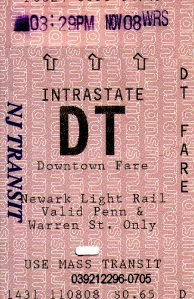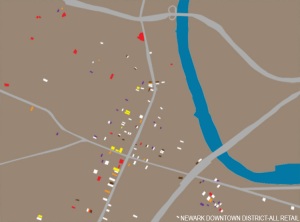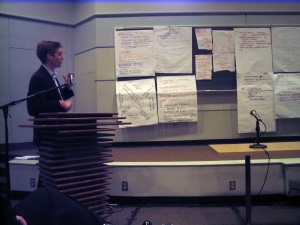I’m back. I took a long break because I wasn’t sure if architecture was something I still wanted to do. I have to go back and finish my M.Arch degree next year and the whole idea did not thrill me. I contemplated even going to law or medical school. But like the old ex-boyfriend that will not go away, me and architecture are stuck like glue. So here we are. I will use my time to get reacquainted with Newark and I would like to eventually move there. As you already know NYC is super expensive, so why not Newark. Stay tuned.
Posts Tagged ‘Newark’
Lessons about Newark
In Field Research on December 18, 2008 at 6:42 pm
Newark Train Ticket
Last Thursday was our final Newark class and it seemed to go by so fast. We had three group presentations today and my group went first. Everything went smoothly and I am proud of the progress that we have made since the beginning of the semester. Newark is definately a city that is transition. It is like a puzzle, and we are all attempting to put the pieces together. In this economy where city, state, and national budgets are busting at the seams…where does this leave rustbelt junctions like Newark? Only time will tell…
Diagram Diaries
In Field Research on December 4, 2008 at 3:58 amWhen I initially started at Parsons, we did a lot of diagrams. Previously, at BG my alma mater, it was very technical. It was all about Francis Ching, in a very straight forward modern outlook. Our projects had basic components: plans, sections, elevations, and a model. But it was one book that opened my eyes to the importance of diagrams, one of the “New York Five”, Peter Eisenman.
Diagrams are to architects as to lawyers to evidence. They help support your case. Or in terms of an architect, your design problem. They are self-explanatory and straight forward. This is what I discovered when I started to create retail diagrams for Newark. Although it is the largest city in New Jersey, its development as been stunted so badly that it is almost overwhelming where to start. And with policy, there are no correct solutions. I think the key to policy it to look at what did not work in the past and do the opposite.
At our group meeting on Tuesday, we were able to trim down our paper and presentation to the basics. Just because retail is not viable right now, does not mean that it always will be…and although the “big box” stores come with its own set of issues, Newark needs something.Towards the end of our meeting, we had a discussion about the past policy initiatives, I was explained why Newark is having 500 million leakage (from an urban planing perspective), or what I like to call
“Top 5 Fantastic Failures of Newark”:
1.Failing to provide current residents with basic retail. Such as supermarkets and drug stores.
2.NJPAC as a “cultural center”. It is so isolated and does not provide any street life that Newark desperately needs.
3. A sports stadium as incentive…it has currently filed for bankruptcy.
4. Lack of waterfront development.Not taking advantage of its strategic position on the Passaic River.
5.Underutilization of the student population and 9-5 workforce.
Development is a tricky thing. Our client Tucker, is making a large investment in a city that has not had any in a while. Kudos to them. But is appears to me all future development is in a holding pattern until Newark becomes a place to be and the middle-class families and young professionals start to flock to the city. Honestly, this is about 5-15 years away. But all is not lost. The untapped retail constituency is already present. Hence my thesis has been created.
Newark has a great base in terms of transportation, universities, a business center but does not utilize the potential of the spending power of students. But there is one organization that is attempting to brige the gap between its university community and Newark residents. The Rutgers Small Business Development Center (RNSBDC) to help entrepreneurs and business owners start and grow sustainable, successful small business through the delivery of appropriate training and technical assistance services and programs. The RNSBDC, less than a year old, has been successful by providing assistance to entrepreneurs.
I would want to design an urban strategy for Newark that expands this idea of accessibility to resources for residents. Unlike my initial thesis for Harlem, this does not feel forced at all and there is less struggle. It is good to be out of your element, which has been true for my policy class. Sometimes architects get so caught up in form making that the design is theoretical based, failing to serve the client. Form follows function.
A Mini Conference @ NJIT
In Field Research on November 19, 2008 at 12:04 amA little over a week ago, my class along traveled to NJIT to discuss the policy and urban planning issues that face Newark. Milano focused on policy, Pratt researched the waterfront, NJIT focused on infrastructure, and Harvard students paid attention to the environmental damage that Newark has suffered.
This program was moderated by Toni Griffin, the current city planner of Newark. After the end of the corrupt Sharpe James administration, Cory Booker was forced to pick up the pieces of what was the planning department. Currently the master plan has not been updated in 60 years! Zoning enforcement was nearly non-existent with heavy manufacturing in adjacent to residential areas. Along with spatial planning, there are many brownfields that exist and lack of green space with the exception of a few parks.But not all is lost.
There seems to be many groups that want Newark to get better, but do not know how. There needs to be a steamling of public and non-profit groups in order to work together and get things done.
As for the retail group, the lack of retail in is not about numbers. Through my mapping exercises, it seems to be the distribution of retail. It is uneven and is basically situated on Broad and Market Street, while underserving the rest of the city. That is why I am also mapping Jersey City and Patterson to see if Newark can learning some succesful strategies from their NJ couterparts.
A Chilly Nite in Newark
In Field Research on October 29, 2008 at 8:42 amLast night I braved the path train and went to Rutgers U for my Milano policy class and thesis research. Newark is in transition right now and the current economic downturn makes revitalization even harder.
About a month ago, I switched my thesis from Harlem to Newark, because my Harlem thesis, even with its good intentions it felt a little bit forced.Thesis prep was really frustrating as a tried to make sense of a market/health clinic.I love Harlem like a second home because I use to live in around 123rd and Broadway, so at the time it made sense to pick a site in my backyard…
But after sitting in my policy class and Newark seemed so more natural to me. The more I learned about Newark the more it reminded me of my hometown, Cleveland. Newark has been though a lot like many cities in post-industrial transition. It has rebounded from corruption, the 1967 riots, and flight to NJ’s surrounding suburbs.
So my working thesis title is “Rustbelt Junction”. “Rustbelt” meaning a post-industrial city, a place whose population exploded with industrial revolution. And “Junction” meaning an interruption, specifically a riot, (for example, the Newark 1967 riots) with segregated, decentralized, and ultimately depleted the city’s urban core. My goal is implement master plans that focus on retail, green affordable housing typologies, and use Newark’s strong educational and medical facilitates as a catalyst for growth.
There is so much research to do, I think that I will be living in Newark by the time graduation comes around…



